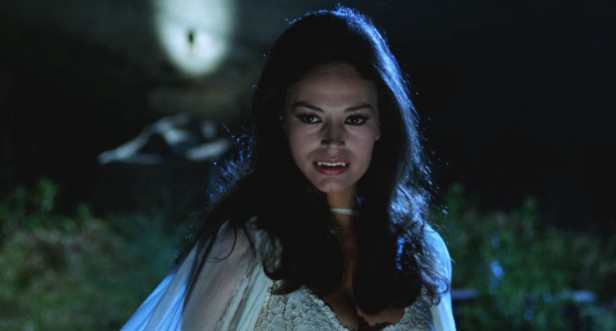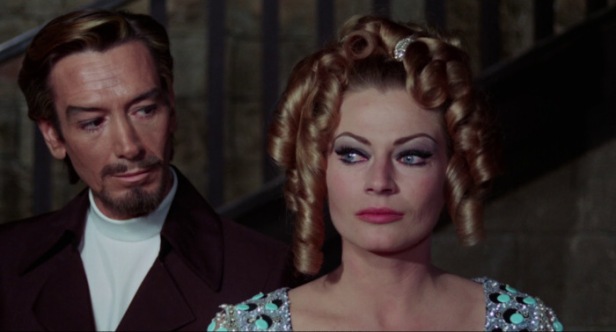Amando de Ossorio is best known for his string of films featuring the blind and undead Knights Templar starting with the classic La noche del terror ciego/Tombs of the Blind Dead (1972). His first genre film had come several years earlier in the shape of the more traditional Gothic, Malenka. It’s an inferior film to the first Blind Dead outing and if it sometimes feels like de Ossorio’s heart isn’t really in it, there’s a good reason for that. While making the first of his Waldemar Daninsky werewolf films, La marca del hombre lobo/Hell’s Creatures/Frankenstein’s Bloody Terror (1968), Paul Naschy had sought the advice of the more experienced de Ossorio, who had started directing short films in the mid-1950s. He told Naschy that the world wasn’t ready for a Spanish horror film, the idea of which he dismissed as “appealing but just not viable.” Yet Naschy’s film hadn’t even been released when de Ossorio suddenly turned up armed with Italian and Spanish money to make his own Gothic.
Virginal fashion model Sylvia Morel (Anita Ekberg) learns that she’s inherited the title of countess along with a large castle. Leaving word with her fiancé Dr Piero Luciani (Gianni Medici), she sets off to explore the castle, oblivious to the concern of the locals. At the castle, she meets her uncle, Count Walbrooke (Julián Ugarte) and is woken in the night by the maidservant Blinka (Adriana Ambesi), who tells her that Walbrooke is an ancient vampire and that she’s in great danger. When Walbrooke catches Blinka trying to get Sylvia out of her room to safety, he takes her away and flogs her, ignoring Sylvia’s pleas for mercy. She also learns of her aunt Malenka, who was burned at the stake accused of being a witch and that the family – and consequently Sylvia herself – is cursed. But nothing about the set up at the castle is quite what it seems…

Sadly one of the hallmarks of de Ossorio’s genre films, and it afflicts the otherwise superior Tombs of the Blind Dead too, is a recurring problem with pacing. De Ossorio’s films are all too often glacial and prone to wandering off down narrative dead ends rather than getting on with telling the main story. And Malenka is certainly no exception. It’s a good-looking film, as so many of de Ossorio’s films tend to be, but one so lacking in pace and atmosphere that one half suspects that he was deliberately trying to make something unappealing enough to prove his point to Naschy about the viability of Spanish horror.
If that was the case (and no-one’s seriously suggesting that it was) then he shoots himself in the foot by accidentally giving us some tantalising glimpses of his gorgeous locations (the village of La Alberca in Salamanca, Castilla y León is particularly lovely, if only very briefly seen) and assembling an equally easy on the eye cast full of some of the most attractive actresses at work in European popular cinema of the time. It may be a stately plod but at least it’s through picturesque locations in the company of attractive people.

But there are so many problems with Malenka that even they can do little to help. It sometimes feels like de Ossorio was so contemptuous of horror that he was trying – but mostly failing – to make a comedy instead. The trio of comic relief vampire hunters, particularly Paul Muller as the drunken Dr Albert certainly seem to have been told to play it all for laughs, but almost everyone else seems to be playing it completely straight. De Ossorio gets things off to a bad start with an inappropriately jaunty theme song and after 90 often interminable minutes, winds up with, depending on which version you see, an ending in which it’s revealed (in the original Spanish version) that it was all a London After Midnight (1927)/Mark of the Vampire (1935)-like ruse, or… something else entirely. In the original cut, Walbrooke, it seems, has faked all the supernatural goings-on in order to drive Sylvia mad and claim her inheritance. English language prints were having none of this silliness but just made matters worse when they added a newly shot sequence – apparently made without de Ossorio’s input – revealing that Walbrooke really had been a vampire all along!
All the ingredients are there. Bosoms heave, suspicious locals cower in terror, fangs are bared, and any number of earlier, better films are shamelessly plundered for plot points, but none of it adds up to much. De Ossorio was seemingly so disinterested in horror that his direction is unimaginative, the pace sluggish and the acting mostly indifferent. Ekberg, in her late 30s at the time the film was made, looks too mature for the role of the virginal heroine, Lorys gets a great scene with Bertha rising from her grave, and some of the supporting cast – Ugarte, Roseanna Yanni and Carlos Casaravilla – had come to the film hot foot from the Naschy film that de Ossorio had been consulted on. Ugarte was a late replacement for Boris Karloff who had been de Ossorio’s first choice for Walbrooke.

Malenka was released in the States under the title Fangs of the Living Dead as part of a triple bill of imported and renamed horrors made to look like they were part of a series – the others were Mario Bava’s marvellous Operazione paura/Kill, Baby… Kill! (1966), renamed Curse of the Living Dead, and Elio Scardamaglia’s La lama nel corpo/The Murder Clinic (1966), given the new title Revenge of the Living Dead. All this happened around 1972, long after George Romero’s Night of the Living Dead (1968) had found its cult audience which explains exactly what distributors Ben Barry and Associates were coming from. The soundtrack by Carlo Savina was recycled in Filippo Walter Ratti’s La notte dei dannati/Night of the Damned (1971) and the character of Malenka turned up in the third volume of Kim Newman’s alternate history Anno Dracula series, Dracula Cha Cha Cha/Judgement of Tears (1998).